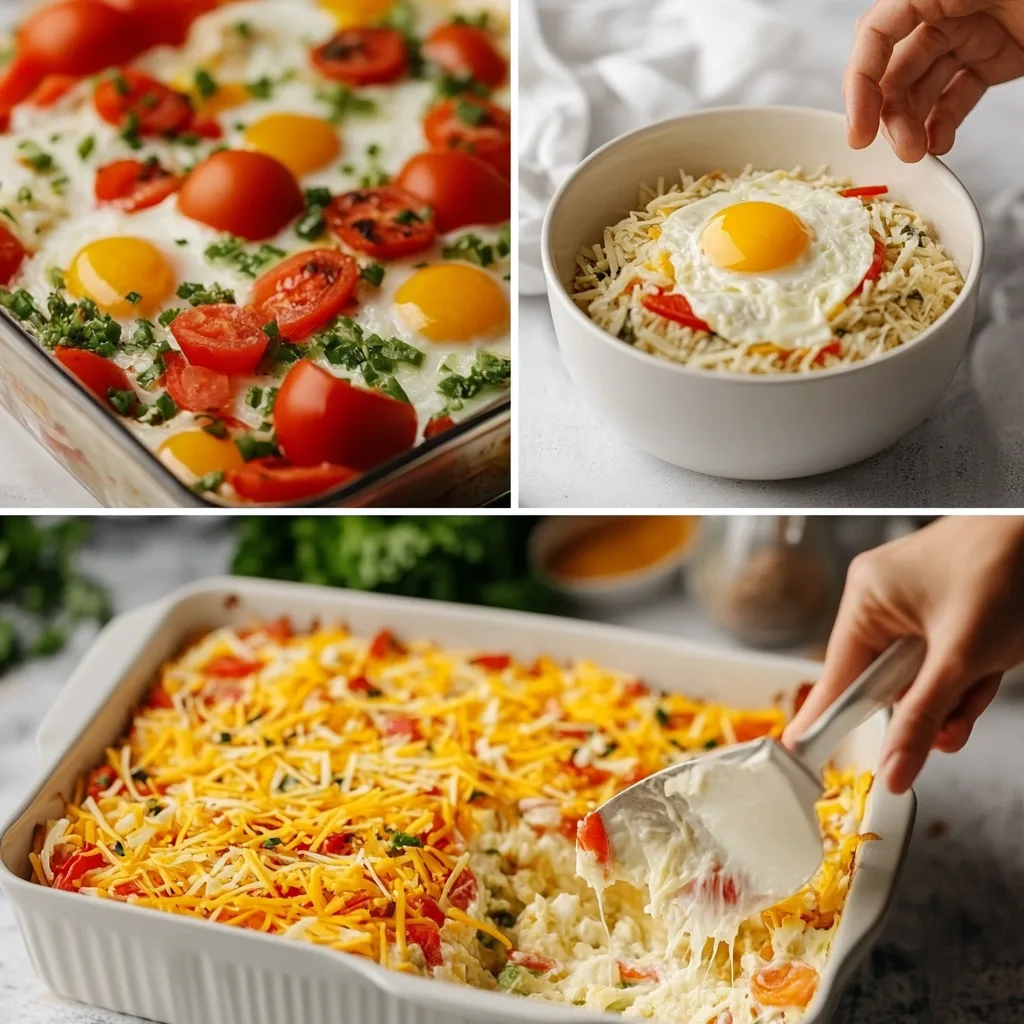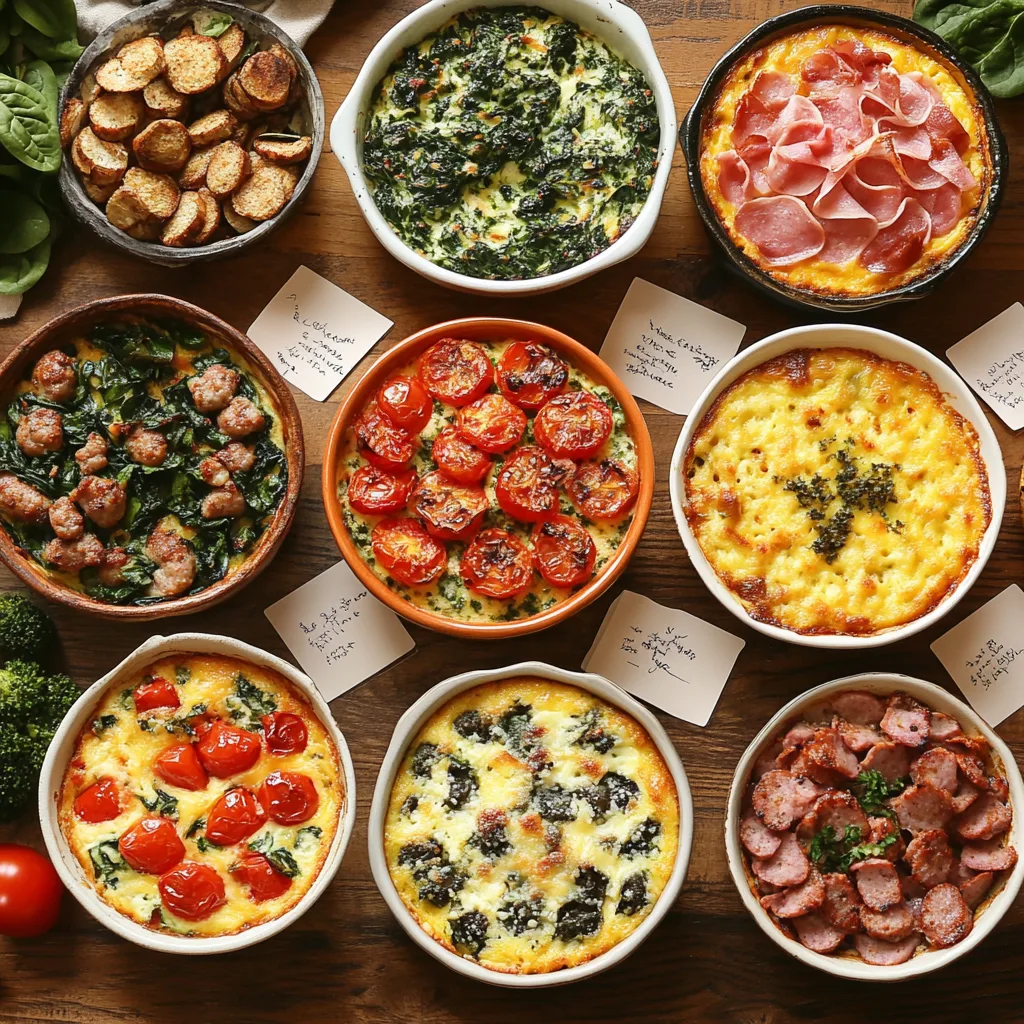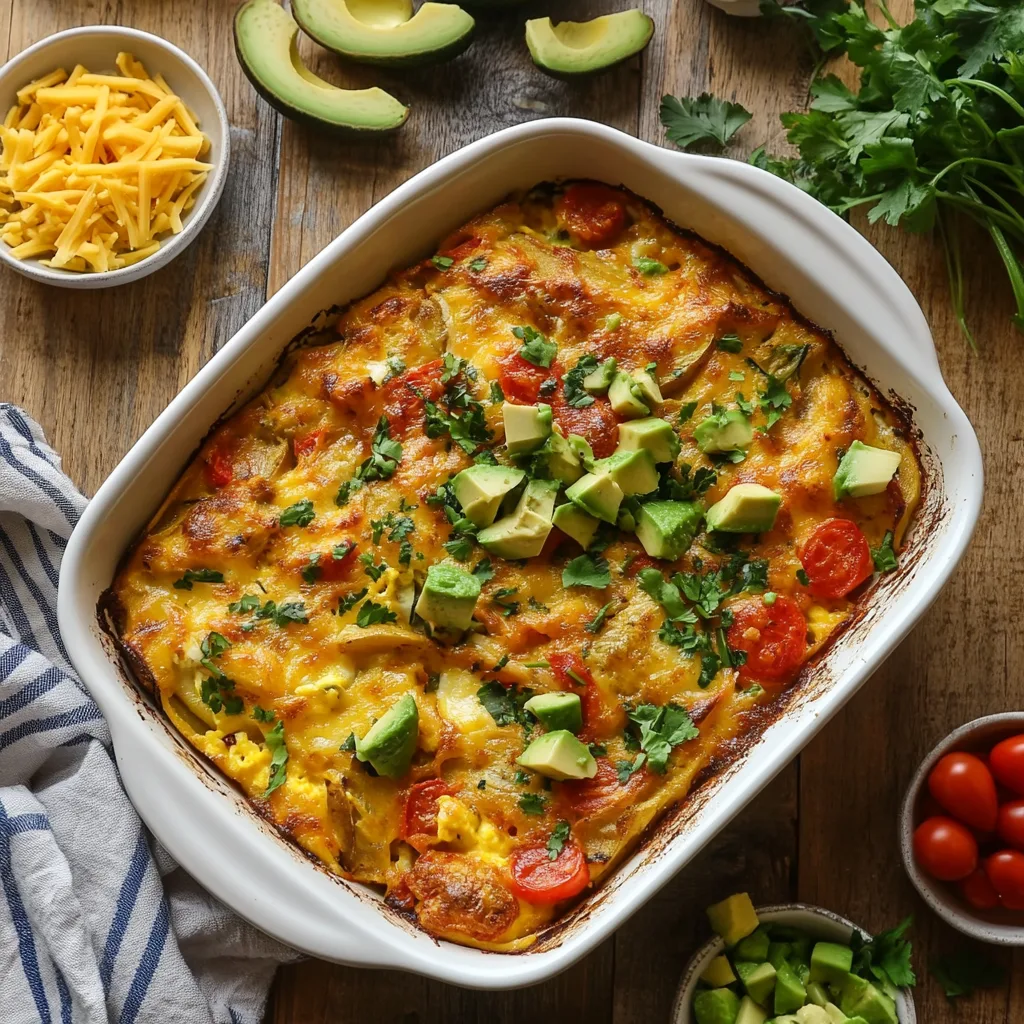Looking for an easy, delicious way to start your day that’s also gluten-free? A gluten-free breakfast casserole is the perfect choice! It’s a hearty, wholesome dish that combines fresh vegetables, savory proteins, and gluten-free alternatives into one flavorful meal. Whether you’re meal prepping for the week or hosting a cozy brunch, this versatile recipe will become a favorite in no time. Let’s jump in and learn how to make your perfect casserole!
Introduction and Basics
What Is a Gluten-Free Breakfast Casserole?
A gluten-free breakfast casserole is exactly what it sounds like—a rich, savory, or sometimes sweet baked dish designed to suit gluten-free diets. Made with layers of wholesome ingredients like eggs, vegetables, and gluten-free bread or potatoes, this dish is an excellent choice for those avoiding gluten due to celiac disease or sensitivity. It’s more than just a meal; it’s comfort food at its finest!
This recipe stands out because it’s simple, satisfying, and endlessly customizable. Think of it as your canvas—add your favorite proteins, veggies, and seasonings to create a masterpiece that reflects your taste and dietary needs.
Why Choose a Gluten-Free Breakfast Casserole?
What’s not to love? Besides being naturally free of gluten, this casserole is:
- Nutritious: It’s packed with proteins, vitamins, and gluten-free carbs.
- Quick and Easy: Perfect for meal prep or an effortless brunch solution.
- Family-Friendly: Everyone, including picky eaters, will enjoy it.
- Adaptable: You can tweak the ingredients to cater to dietary restrictions or preferences.
And here’s the best part—it’s budget-friendly! Most of the ingredients are pantry staples, and you can use whatever you already have in the fridge.
Ingredients to Make a Gluten-Free Breakfast Casserole
To prepare a gluten-free breakfast casserole, you’ll need:
- Base Ingredients: Eggs, gluten-free bread, or shredded potatoes (or both).
- Protein Options: Turkey sausage, diced chicken, or plant-based alternatives.
- Vegetables: Spinach, bell peppers, onions, and mushrooms are popular choices.
- Dairy: Shredded cheese or dairy-free cheese, depending on your preference.
- Seasonings: Salt, pepper, garlic powder, and paprika to enhance flavors.
When shopping for ingredients, always check labels to confirm that packaged products like cheese or seasonings are certified gluten-free.
How to Prepare a Gluten-Free Breakfast Casserole
Step-by-Step Recipe Guide
Creating a gluten-free breakfast casserole might sound fancy, but it’s as easy as pie. With just a little preparation and a dash of creativity, you’ll have a hearty dish ready in no time.

1. Prepping Your Ingredients
The first step is to gather and prepare everything you’ll need. Crack your eggs into a bowl and whisk them until they’re fluffy. If you’re using gluten-free bread, cut it into bite-sized pieces, or grate your potatoes if they’re the base of your casserole. For vegetables, wash, chop, and pat them dry to avoid excess moisture.
If you’re adding protein like turkey sausage or diced chicken, cook them ahead of time. Season your ingredients with salt, pepper, and other spices that complement your tastes. For instance, garlic powder and paprika add a warm, smoky flavor.
2. Choosing the Right Baking Dish
Select a medium to large baking dish that can hold all your layers comfortably. Grease it lightly with olive oil or butter to prevent sticking, which will also make cleanup a breeze.
3. Layering Your Ingredients
This step is where the magic happens. Start with a base layer—bread pieces, shredded potatoes, or a mix of both. Follow this with a layer of cooked vegetables and your chosen protein. Sprinkle half of the shredded cheese over the layers, then repeat the process until you’ve used up your ingredients.
Finally, pour the whisked eggs over the entire dish. Make sure the egg mixture seeps into every corner, binding the layers together. Add the remaining cheese on top for a golden, bubbly finish when it bakes.
4. Baking the Casserole
Preheat your oven to 375°F (190°C). Cover the dish with foil to trap moisture and bake for 30 minutes. Then, remove the foil and bake for an additional 15–20 minutes or until the top is golden brown and the eggs are fully set. You can test this by inserting a knife into the center; if it comes out clean, your casserole is done.

Customizing Your Recipe for Taste and Nutrition
While the basic recipe is great, personalizing it adds a unique touch that reflects your preferences.
1. Protein Additions
Don’t feel limited by traditional options like turkey sausage or chicken. You can use plant-based proteins like tofu or lentils, which soak up the flavors of the spices and veggies beautifully.
2. Dairy-Free and Vegan Choices
For those avoiding dairy, consider using coconut milk or cashew-based cheese alternatives. These options add creaminess without compromising on flavor. Flaxseed or chia seed “eggs” can be an excellent substitute for real eggs in vegan recipes.
3. Adding More Vegetables
Vegetables not only add vibrant colors but also boost the nutritional value of your casserole. Bell peppers bring a crunch, spinach adds a dose of iron, and zucchini or mushrooms lend a mild, earthy flavor. Remember to sauté watery vegetables beforehand to prevent your dish from becoming soggy.
Storing and Reheating Tips
How to Store a Gluten-Free Breakfast Casserole
One of the best things about a gluten-free breakfast casserole is its convenience, especially for meal prep. If you have leftovers or want to prepare it ahead of time, proper storage is key to keeping it fresh and flavorful.
1. Refrigerating Your Casserole
For short-term storage, allow the casserole to cool completely before transferring it to an airtight container or covering the baking dish with a lid or plastic wrap. Refrigerated casseroles can stay fresh for up to 3–4 days. If you plan to eat individual servings, cutting the casserole into portions before storing makes it easier to grab and go.
2. Freezing the Casserole
To store it for a longer time, freezing is the way to go. Cut the cooled casserole into portions and wrap each piece tightly in plastic wrap. Then, place the wrapped portions in a freezer-safe container or zip-lock bag. This prevents freezer burn and keeps the casserole tasting fresh for up to 2–3 months.
If you’re freezing the entire casserole, it’s best to do so in the dish it was baked in. Cover it tightly with aluminum foil and place it in the freezer. When you’re ready to reheat, thaw it in the refrigerator overnight.
3. Tips for Preserving Quality
To maintain the casserole’s texture and flavor during storage, make sure it’s cooled properly before sealing. Excess steam can create condensation, leading to sogginess. Always use containers or wraps that are specifically designed for food storage to keep it safe and tasting great.
Best Practices for Reheating
Reheating a gluten-free breakfast casserole is all about bringing it back to its original texture and flavor without drying it out or making it mushy.
1. Reheating in the Oven
This method is the best for maintaining the original taste and texture. Preheat your oven to 350°F (175°C). If reheating a full casserole, keep it covered with aluminum foil to retain moisture. Bake for 15–20 minutes or until the center is warmed through. For individual slices, 10–12 minutes should suffice.
2. Using a Microwave
For quicker reheating, the microwave is a great option. Place an individual slice on a microwave-safe plate and cover it with a damp paper towel to prevent it from drying out. Heat on medium power for 1–2 minutes, checking frequently to avoid overcooking.
3. Reheating on the Stovetop
If you prefer a slightly crispy base, reheating on the stovetop works well. Place a slice in a non-stick skillet over low heat and cover it with a lid. Heat for about 5 minutes, flipping once to warm it evenly.
4. Tips for Perfect Reheating
- Avoid overcooking, as it can make the eggs rubbery and dry.
- Add a sprinkle of fresh cheese or a drizzle of olive oil before reheating to boost flavor and moisture.
- Always check that the casserole is heated evenly, especially if reheating from frozen.
Gluten-Free Breakfast Casserole Variations
Why Customize Your Gluten-Free Casserole?
One of the best things about a gluten-free breakfast casserole is how flexible it is. You can make endless changes to match your taste, diet, or even the ingredients you already have. With a few swaps or additions, this dish can feel fresh every time you make it. Let’s look at some delicious ways to mix things up.

Creative Recipe Variations
Southwest Style: A Spicy Kick
If you enjoy bold flavors, try a Southwest-inspired casserole. First, layer black beans, corn, and diced tomatoes for a base. Next, sprinkle a mix of cumin, chili powder, and smoked paprika for extra heat. After that, top it off with cheddar and Monterey Jack cheese to bring all the flavors together. Finally, garnish with fresh cilantro and serve with guacamole or salsa for a flavorful breakfast or brunch.
Mediterranean Twist: A Fresh Take
For a lighter option, go with Mediterranean flavors. Start by adding olives, sun-dried tomatoes, spinach, and artichoke hearts to your layers. Then, use feta cheese for its tangy taste, which goes perfectly with oregano and garlic. This variation feels fancy but is still incredibly simple to prepare.
Sweet Breakfast Casseroles: A Dessert-Like Treat
Not every casserole has to be savory. For a sweeter option, use gluten-free oats as your base. Add almond milk, a touch of cinnamon, and layers of fruits like blueberries or apples. Finally, drizzle some honey or maple syrup before baking to make it both satisfying and wholesome. This version is perfect for special occasions or anyone with a sweet tooth.
Pairing Ideas for a Complete Meal
Why Add Sides?
Even though a gluten-free breakfast casserole can stand alone, pairing it with the right sides can make the meal even better. These ideas work well for everything from casual breakfasts to elegant brunches.
Fresh Fruit Salad: Light and Sweet
A bowl of mixed berries, melon, and citrus slices is the perfect match for a rich casserole. The natural sweetness of the fruit balances the heavier, savory flavors of the main dish.
Gluten-Free Bread or Muffins: A Comforting Side
Serve your casserole with gluten-free muffins or toast for a classic breakfast feel. You can add butter, jam, or avocado to make it even tastier. It’s a simple side that everyone loves.
Smoothies and Fresh Juices: A Nutritious Add-On
Drinks like a spinach and banana smoothie or a fresh orange juice not only pair beautifully with the casserole but also add a burst of energy to start your day. These options are quick to make and full of vitamins.
Savory Vegetables: A Heartier Option
For a more filling meal, roasted vegetables like sweet potatoes or asparagus work wonderfully as sides. They’re easy to prepare and add extra nutrients to the meal.
Experimenting with Seasonal Ingredients
Make It Fresh Every Time
You can keep your casserole exciting by using ingredients that are in season. For example, in summer, add zucchini, cherry tomatoes, and fresh basil. In winter, roasted butternut squash, kale, and caramelized onions are excellent choices. Seasonal swaps not only keep things interesting but also allow you to use fresh, affordable produce.
FAQs About Gluten-Free Breakfast Casseroles
What breakfast meat is gluten-free?
Breakfast meats like turkey sausage, chicken sausage, and unseasoned ham are usually gluten-free. However, some brands add fillers or seasonings that may contain gluten, so it’s important to always check the labels. Look for “certified gluten-free” options to be completely safe.
What’s the difference between a frittata and a breakfast casserole?
Frittata Basics
A frittata is similar to an omelet but thicker, and it’s cooked mostly on the stovetop. Eggs are the main ingredient, and it doesn’t typically include a bread or potato layer.
Breakfast Casserole Explained
A breakfast casserole, on the other hand, is baked in the oven. It’s layered with gluten-free bread, potatoes, or even tortillas for a heartier texture. Think of a casserole as a more filling, oven-baked dish compared to the lighter frittata.
Are hotel breakfast potatoes gluten-free?
When Are Potatoes Safe?
Plain, unseasoned potatoes are naturally gluten-free. If the hotel serves simple roasted or boiled potatoes, they’re likely safe.
When to Ask Questions
However, some hotel kitchens add coatings, seasonings, or use fryers that might cause cross-contamination with gluten-containing foods. Always ask how the potatoes were prepared to stay on the safe side.
What can I eat for breakfast if I can’t eat eggs or gluten?
Savory Options
Try gluten-free oatmeal topped with fresh fruits and nuts. A roasted vegetable hash with sweet potatoes and spinach is another filling choice.
Sweet Breakfasts
For something sweet, enjoy chia seed pudding or a smoothie bowl made with almond milk and your favorite fruits. Gluten-free toast with nut butter is also a great option.
Can I make a gluten-free breakfast casserole ahead of time?
Yes, you can! Prepare the casserole the night before by layering all the ingredients in the dish, then cover and refrigerate it. In the morning, simply bake it as directed. This is perfect for busy mornings or hosting brunch gatherings.
What are the best gluten-free substitutes for bread in a casserole?
Bread Alternatives
If you want to skip gluten-free bread, shredded potatoes or sweet potatoes work beautifully as a base.
Other Substitutes
You could also try gluten-free tortillas, quinoa, or even cooked rice. Each option gives the casserole a unique texture and flavor.
How do I check if store-bought ingredients are gluten-free?
Read the Label
Always read the packaging carefully. Many gluten-free items are labeled with certifications or symbols, making them easier to spot.
Double-Check Ingredients
Look for hidden gluten in sauces, seasonings, or processed foods. If in doubt, check the brand’s website or contact the company directly.
Can I freeze a gluten-free breakfast casserole?
Freezing the Dish
Yes! Let the casserole cool completely before freezing. You can wrap individual slices in plastic wrap or freeze the entire dish by covering it tightly with foil.
Thawing and Reheating
Thaw it in the fridge overnight, then reheat in the oven at 350°F (175°C) until warmed through.
Conclusion
A gluten-free breakfast casserole is a versatile and delicious meal that works for any occasion—be it a family brunch, meal prep for the week, or a cozy morning at home. Whether you’re craving a hearty sausage, egg, and hashbrown casserole, or prefer something lighter like a dairy-free breakfast casserole, there are endless ways to make this dish your own. It’s not only easy to prepare but also caters to a variety of dietary needs.
For those seeking inspiration, there are many gluten-free breakfast casserole recipes available that include ingredients like fresh vegetables, gluten-free bread alternatives, and flavorful proteins. This dish ensures you’ll never get bored, with so many options to keep your mornings exciting and nutritious.
Whether you’re a fan of savory combinations or looking for a gf breakfast casserole packed with bold flavors, this recipe will become a staple in your kitchen. So, gather your favorite ingredients, follow these tips, and enjoy the perfect gluten-free breakfast every time.
External Links
– Guide to Celiac Disease and Gluten-Free Diets

